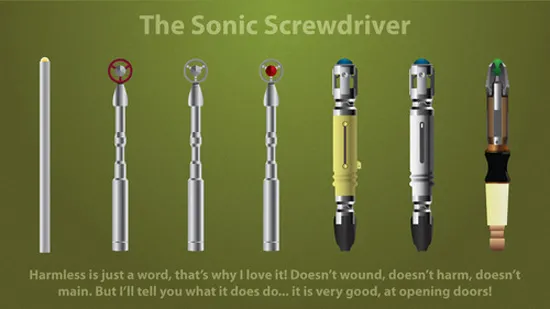I’m getting weird feelings. Like foresight into a massive time paradox, the result of which could cause a chain reaction that would unravel the very fabric of the space-time continuum and destroy the entire universe. The cause? Scientists taking ideas from science fiction in order to create real devices which will somehow go on to change how fiction writers from the past came up with ideas for no-yet-invented sci-fi devices. (Mark my words, that will be a movie one day). Scientists at the University of Dundee in the UK have created a device that uses ultrasound waves to turn object. In other words, screw them. In even more words, OH MY GOD THEY’VE MADE A SONIC SCREWDRIVER.
“When the scriptwriters for Doctor Who imagined a futuristic device, they came up with the Sonic Screwdriver. Now a team of physicists at the University of Dundee have taken equipment designed for MRI-guided focused ultrasound surgery and demonstrated a real Sonic Screwdriver – lifting and spinning a free-floating 10 cm diameter rubber disk with an ultrasound beam,”says a press release on the Dundee website. “The Dundee researchers used energy from an ultrasound array to form a beam that can both carry momentum to push away an object in its path and, by using a beam shaped like a helix or vortex, cause the object to rotate.”
Here’s a video showing how it works:
“This experiment not only confirms a fundamental physics theory but also demonstrates a new level of control over ultrasound beams which can also be applied to non-invasive ultrasound surgery, targeted drug delivery and ultrasonic manipulation of cells,” said Dr. Mike MacDonald, of the Institute for Medical Science and Technology (IMSAT) at Dundee.
This isn’t the first time science mirrored science fiction. Most recently we reported that Microsoft is working on a universal translator much like the ones utilized in Star Trek. But as a TARDIS is quite complex, it makes sense scientists would choose to work on a simpler technology from Doctor Who, the sonic screwdriver.
“The ultrasound beam generated by the Dundee team resembles the ‘double-helix’ structure of DNA but with many more twisted strands, or helices. This vortex beam generates a rotating, angular component of momentum that can exert torque on an object,” says the release. “In the recent publication they showed how they could generate vortex beams with many intertwined helices, using a 1000-element ultrasound transducer array as an acoustic hologram. These beams are powerful enough to levitate and spin the 90g disk made of ultrasonic absorber in water.”
So, not quite yet at lock picking or operating computers, but they’re making progress. “Like Dr Who’s own device, our sonic screwdriver is capable of much more than just spinning things around,” said MacDonald.
“The research forms part of a UK-wide Engineering and Physical Sciences Research Council (EPSRC) project known as ‘Sonotweezers’, which involves the Universities of Bristol, Dundee, Glasgow and Southampton as well as seven industry partners. SonotweezersTM aim to bring dexterity and flexibility to ultrasonic manipulation, allowing applications in a wide range of topics including regenerative medicine, tissue engineering, developmental biology and physics.”
The results will be published in the American Physical Society’s journal Physical Review Letters but you can read a bit more of the technical jargon in the press release. I’ll just be here in a constant TennantWHAT loop.
(via The Beat, image by WillZMahrler on DeviantArt)









Published: Apr 19, 2012 11:54 am